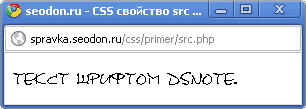Css what is src
Свойство CSS src применяется для подключения и загрузки дополнительного шрифта, чтобы в дальнейшем обращаться к нему с помощью свойства font-family. Это бывает необходимо, когда автор решает использовать на странице не самый распространенный шрифт, которого с большой вероятностью может не быть на компьютере пользователя.
Тип свойства
Применяется: внутри At-правила @font-face.
Значения
Значением свойства src является ключевое слово inherit либо определенные параметры служащие для подключения шрифта.
- local(‘имя шрифта’) — конструкция local(), где в скобках указывается имя шрифта. Оно будет использовано браузером для поиска данного шрифта на компьютере пользователя. Имя можно брать в необязательные двойные (» «) или одинарные (‘ ‘) кавычки.
- url(‘адрес файла’) — конструкция url(), где в скобках указывается полный или относительный адрес файла со шрифтом. Сам адрес можно брать в двойные или одинарные кавычки.
- format(‘формат шрифта’) — конструкция format(), где в скобках указывается один или несколько (через запятую) форматов шрифта (см. таблицу ниже). Если браузер не поддерживает указанные форматы, то он не будет загружать шрифт. Каждый формат шрифта необходимо брать в двойные или одинарные кавычки.
- inherit — наследует значение src от родительского элемента.
Процентная запись: не существует.
Значение по умолчанию: нет.
| Формат | Описание | Расширения |
|---|---|---|
| «truetype» | Шрифты TrueType | *.ttf |
| «opentype» | Шрифты OpenType | *.ttf, *.otf |
| «truetype-aat» | Шрифты TrueType с расширениями Apple Advanced Typography | *.ttf |
| «embedded-opentype» | Шрифты Embedded OpenType | *.eot |
| «svg» | Шрифты SVG Font | *.svg, *.svgz |
Указание подключаемого шрифта происходит по следующим правилам:
- Можно использовать одно из двух — либо local(‘имя шрифта’) , либо url(‘адрес файла’) .
- Если используется url(‘адрес файла’) , то затем (через пробел) можно установить конструкцию format(‘формат шрифта’) .
- Допускается указание нескольких шрифтов через запятую. Тогда, если браузер не найдет или не поддерживает первый шрифт, он перейдет к обработке второго и т.д.
src: url('fonts/bestfont.ttf'); src: url('fonts/bestfont.ttf') format("opentype"), url('fonts/superfont.ttf') format("opentype", "truetype-aat"); src: local('Arial'), local('Verdana'), url('fonts/arial.ttf') format("truetype");Синтаксис
src: [url [format(‘формат шрифта'[, ‘формат шрифта’]*)] | local(‘имя шрифта’)] [, url [format(‘формат шрифта'[, ‘формат шрифта’]*)] | local(‘имя шрифта’)]*
Пример CSS: использование src
Текст шрифтом Dsnote.
Результат. Использование свойства CSS src.
Версии CSS
Браузеры
| Браузер: | Internet Explorer | Google Chrome | Mozilla Firefox | Opera | Safari | |||
| Версия: | До 9.0 | 9.0 и выше | 2.0 и выше | 2.0 и 3.0 | 3.6 и выше | 9.2 и 9.6 | 10.0 и выше | 3.1 и выше |
| Поддержка: | Частично | Да | Да | Нет | Да | Нет | Да | Да |
Браузеры Internet Explorer до версии 9.0 игнорируют свойство src , если в нем присутствует format(‘формат шрифта’) , а также понимают только шрифты формата EOT , который активно продвигается компаниями Microsoft и Adobe.
HTML src Attribute
The src attribute specifies the location (URL) of the external resource.
Applies to
The src attribute can be used on the following elements:
Examples
Audio Example
Embed Example
An embedded flash animation:
Iframe Example
Img Example
An image is marked up as follows:
Input Example
An HTML form with an image that represents the submit button:
Script Example
Point to an external JavaScript file:
Source Example
An audio player with two source files. The browser should choose which file (if any) it has support for:
Track Example
A video with two subtitle tracks:
Video Example
Browser Support
The src attribute has the following browser support for each element:
| Element | |||||
|---|---|---|---|---|---|
| audio | 4.0 | 9.0 | 3.5 | 4.0 | 10.5 |
| embed | Yes | Yes | Yes | Yes | Yes |
| iframe | Yes | Yes | Yes | Yes | Yes |
| img | Yes | Yes | Yes | Yes | Yes |
| input | 1.0 | 2.0 | 1.0 | 1.0 | 1.0 |
| script | Yes | Yes | Yes | Yes | Yes |
| source | 4.0 | 9.0 | 3.5 | 4.0 | 10.5 |
| track | 18.0 | 10.0 | 31.0 | 6.0 | 15.0 |
| video | 4.0 | 9.0 | 3.5 | 4.0 | 10.5 |
HTML ![]() Tag
Tag
The tag is used to embed an image in an HTML page.
Images are not technically inserted into a web page; images are linked to web pages. The tag creates a holding space for the referenced image.
The tag has two required attributes:
- src — Specifies the path to the image
- alt — Specifies an alternate text for the image, if the image for some reason cannot be displayed
Note: Also, always specify the width and height of an image. If width and height are not specified, the page might flicker while the image loads.
Tip: To link an image to another document, simply nest the tag inside an tag (see example below).
Browser Support
Attributes
| Attribute | Value | Description |
|---|---|---|
| alt | text | Specifies an alternate text for an image |
| crossorigin | anonymous use-credentials | Allow images from third-party sites that allow cross-origin access to be used with canvas |
| height | pixels | Specifies the height of an image |
| ismap | ismap | Specifies an image as a server-side image map |
| loading | eager lazy | Specifies whether a browser should load an image immediately or to defer loading of images until some conditions are met |
| longdesc | URL | Specifies a URL to a detailed description of an image |
| referrerpolicy | no-referrer no-referrer-when-downgrade origin origin-when-cross-origin unsafe-url | Specifies which referrer information to use when fetching an image |
| sizes | sizes | Specifies image sizes for different page layouts |
| src | URL | Specifies the path to the image |
| srcset | URL-list | Specifies a list of image files to use in different situations |
| usemap | #mapname | Specifies an image as a client-side image map |
| width | pixels | Specifies the width of an image |

